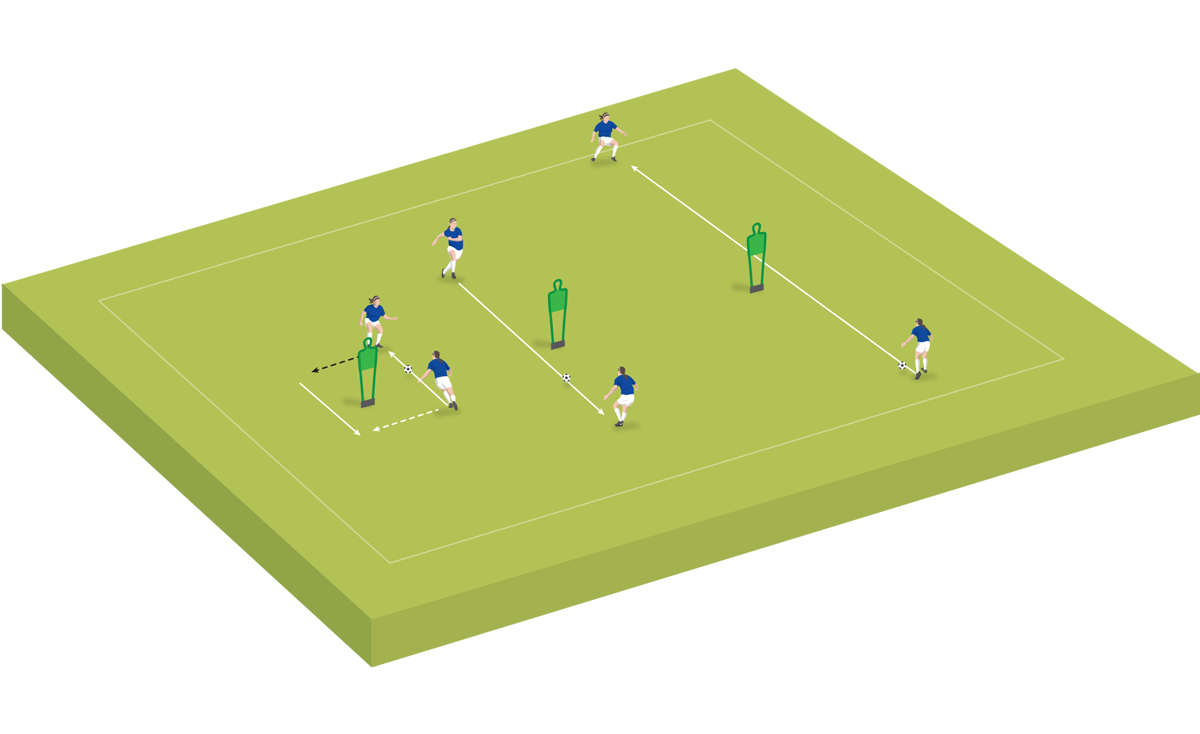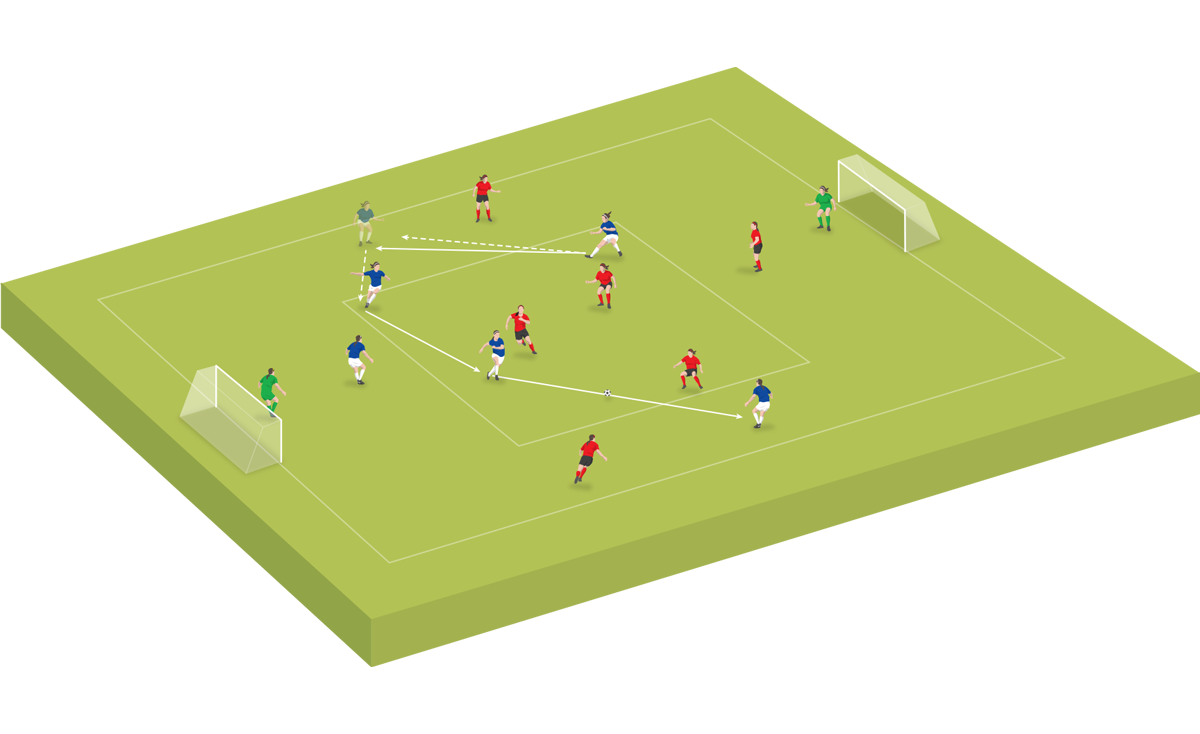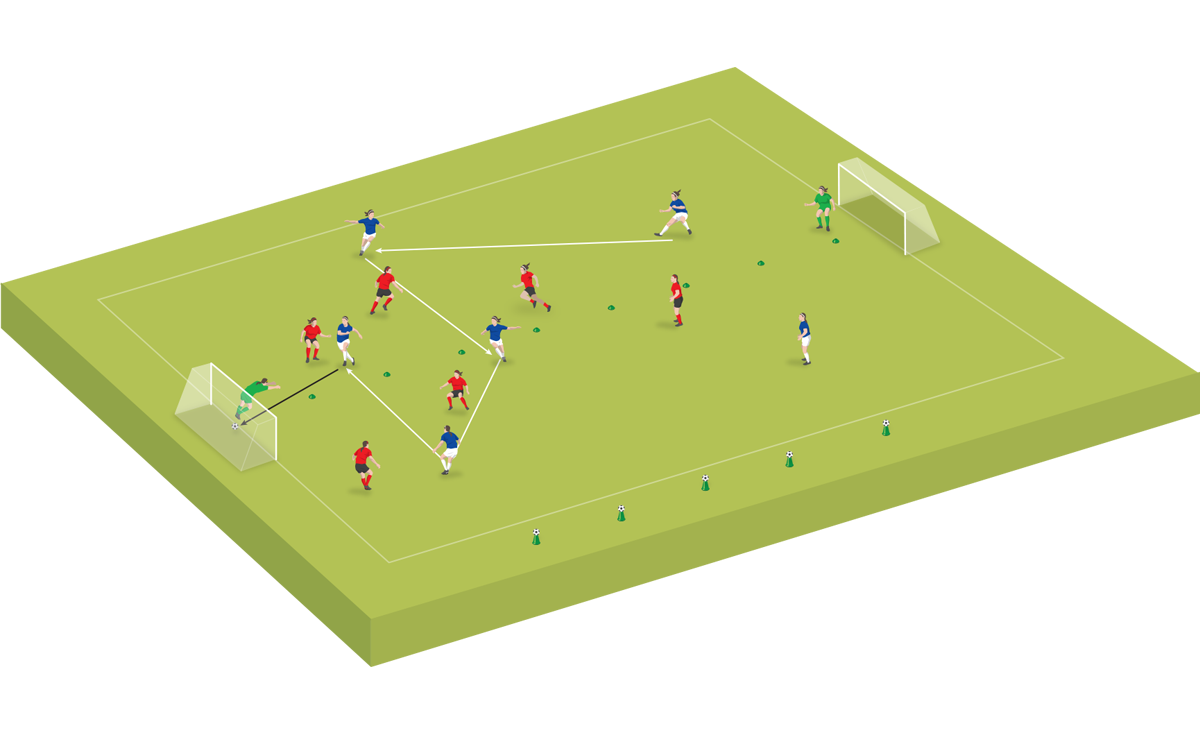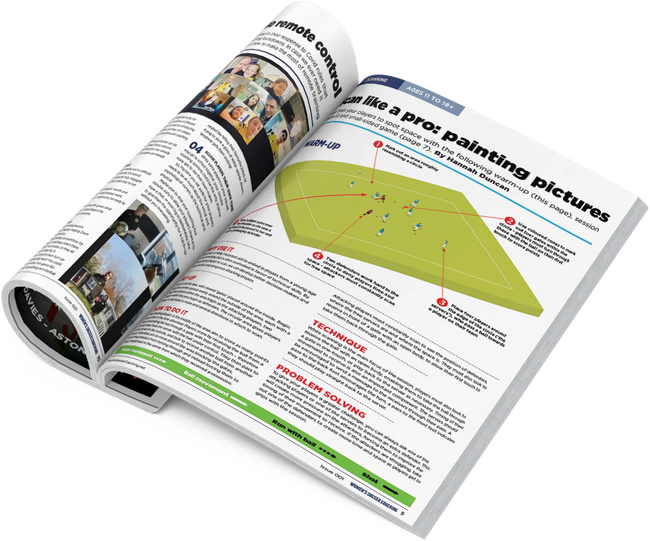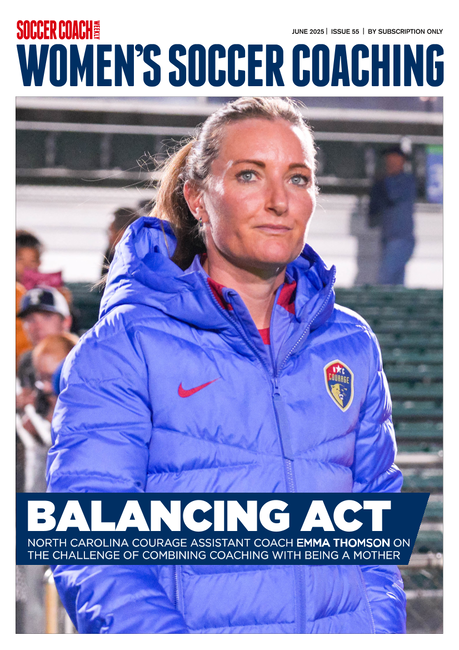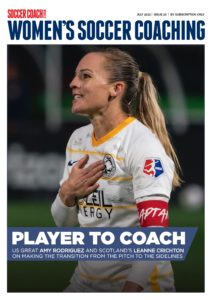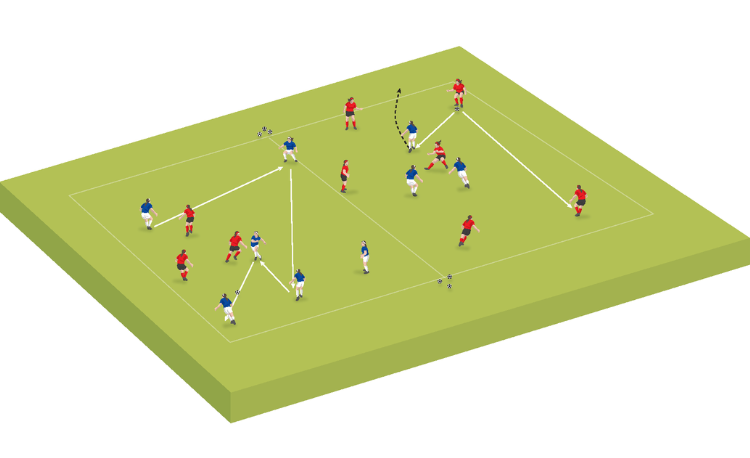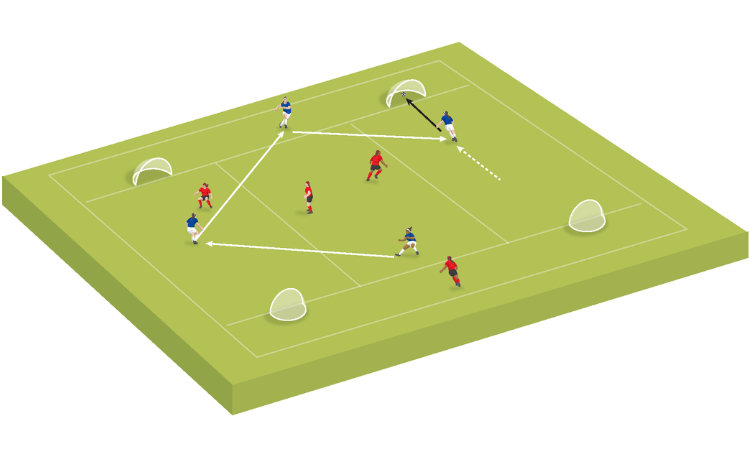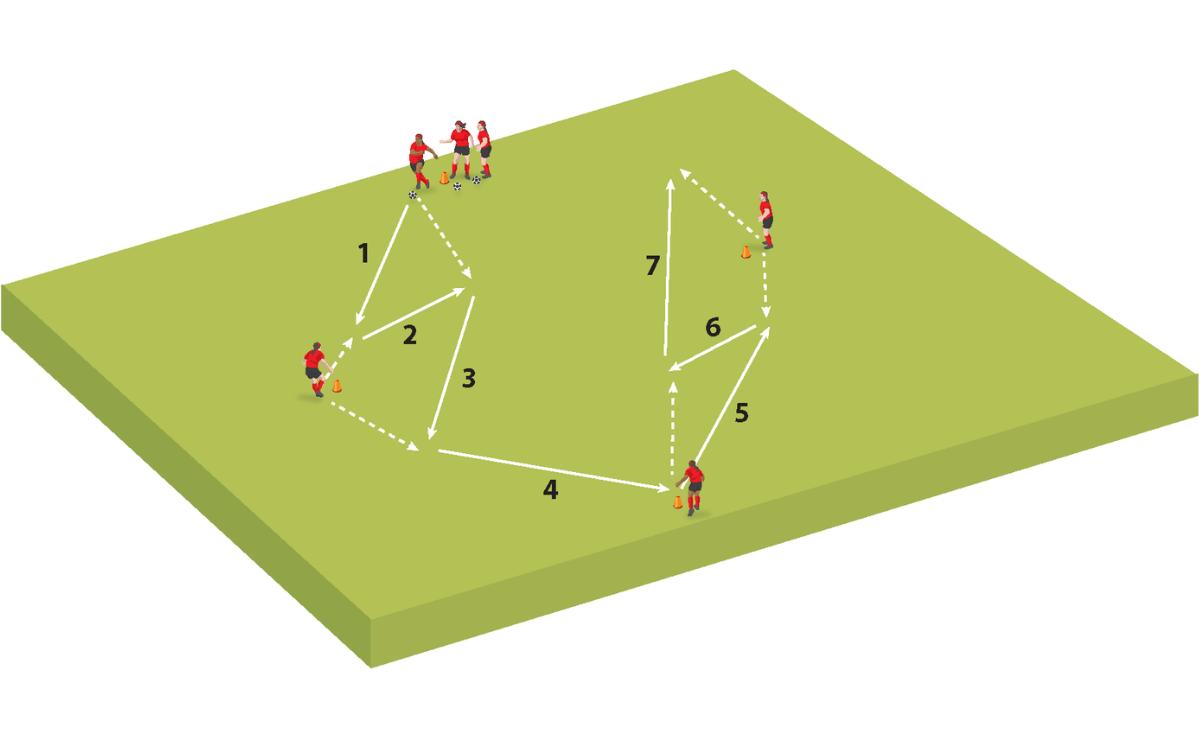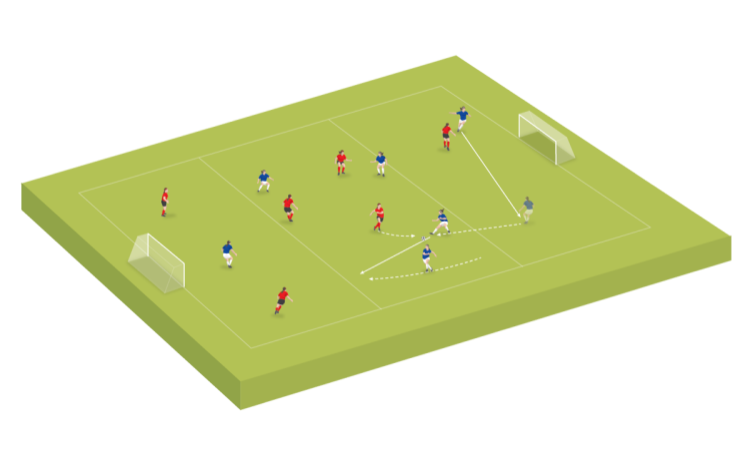Flicking the switch
A three-part session to equip players with the skills and the intuition to switch play quickly. Session structure: Practice 1, Practice 2, Practice 3.
Practice 1
WHY USE IT
This practice encourages players to use a variety of different passes and enhances first-touch control - both crucial for switching play quickly and efficiently.
Set-up
Set up two cones eight yards apart with a mannequin (or tall cone if a mannequin isn’t available) in between. The distance can be adapted depending on the age and ability of your players.
Suggest a few passes that could be used at that distance e.g. in-step, outside of the foot.
HOW TO play
Players should move out of the line of the mannequin to pass and receive. They should receive with a variety of first touches (e.g across the body or outside of the boot) to push across the mannequin and pass the ball back to their team-mate. Repeat.
ADAPTATIONS
Allow players to choose between a range of distances and encourage them to choose the correct weighted pass for the distance. You can also finish with a competition, where players select a distance and earn a point per successful pass - but lose a point each time the ball hits the mannequin or isn’t properly controlled.
For more advanced players, suggest a maximum of two touches, or start closer to the mannequin.
COACHING POINTS
-
Coach body position to encourage a positive first touch - open the hips to receive and push the ball into space around the mannequin.
-
Coach the importance of the right weight and type of pass, depending on distance e.g. in-step for short distance, drilled (with laces) for mid-distance and lofted or drilled for long distance.
-
Encourage players to move the ball quickly but in a controlled and composed manner.
1. Players start in pairs, passing a ball between them. Encourage players to move off the line of the mannequin to pass and receive
2. Players can use different types of pass, depending on the distance
3. To challenge players more, increase the passing distance. You can also make it a competition to earn points for completed passes
Practice 2
WHY USE IT
This practice encourages players to switch play quickly to positively break out with an opportunity to score.
Set-up
Mark out an area relative to the age, ability and number of players, with a goal at each end and a smaller central area. Divide players into two teams, each with a goalkeeper.
One defender from each team starts outside the central square, defending their team’s goal. One player from each team starts either side of the central square. Play 3v3 within the square.
HOW TO play
Players must complete a minimum of three passes, going from side to side. They must pass to their team-mate on the outside and for it to be successful, the receiver must have a positive first touch inside the box to continue the attack. The player who passed the ball outside must then take up that position.
After a minimum of three switches of play, two attackers can break out to create a 2v2 with the defender and goalkeeper. If the defender wins possession, they can play straight into the central square to restart the attack for their team.
Completed three switches of play = 1 point
Completed three switches of play and a goal = 3 points
PROGRESSIONS & ADAPTATIONS
Increase the number of passes in order to break out; Put conditions on the central player – e.g. maximum touches, isolated feet to use; For more advanced players, make the central area smaller to encourage a more controlled first touch and closer combinations.
COACHING POINTS
-
Coach the body position and checking the shoulder before receiving, to exploit space.
-
Encourage movement into space to receive and enhance time on the ball.
-
Encourage players to use a variety of passes to switch play quickly and efficiently.
-
Coach the importance of attacking quickly and exploiting the space created by switching play quickly.
Related Files
1. Start with 3v3 in the central area, a wide player for each team on the outside and a defender and goalkeeper for each team
2. Teams aim to switch play at least three times between their wide players
3. The outside player receiving the ball must take a positive first touch into the central area, while the passer takes their place
4. After three successful switches, the team can break out with two attackers to try and score against the opponent’s defender and goalkeeper
Practice 3
WHY USE IT
This practice encourages players to switch play to create space to exploit in attack.
Set-up
Mark out a pitch relative to the age, ability and number of your players, with a goal at each end. Place a line of cones down the middle (flat cones if possible). Divide players into two teams. Place five balls along one side, each balanced on top of a cone.
HOW TO play
Teams aim to switch play either forwards or sideways, by making a successful pass across the central line, before scoring a goal.
If a goal is scored, the scoring team must collect the ball and attempt to knock another ball off one of the cones on the sideline, while remaining on the pitch.
If a goal is scored without a switch in play, the scoring team gets one attempt. If play is switched and a goal scored, they get three attempts.
The coach play another ball in for the game to continue. The first team to knock all the balls off the cones, wins.
PROGRESSIONS & ADAPTATIONS
Teams can switch play by moving the ball in any direction, e.g. backwards.
COACHING POINTS
-
Move the ball quickly to create space to pass into.
-
Positive body language and communication is important to encourage team-mates to pass the ball in congested areas.
-
Encourage players to take care of the ball and be patient when building the attack - switch play until spaces are created.
- Divide players into two teams with the pitch split in half lengthways. Place some balls on top of cones along the touchline
-
Teams aim to switch play across the central line before scoring
-
If a team switches play before scoring, they get three attempts at knocking a ball off a cone on the sideline. A goal without switching play gives one attempt. The first team to knock all the balls off, wins
Newsletter Sign Up
Newsletter Sign Up
Discover the simple way to become a more effective, more successful soccer coach
In a recent survey 89% of subscribers said Women's Soccer Coaching makes them more confident, 91% said Women's Soccer Coaching makes them a more effective coach and 93% said Women's Soccer Coaching makes them more inspired.
*includes 3 coaching manuals
Get Inspired
All the latest techniques and approaches
Women's Soccer Coaching offers proven and easy to use soccer drills, coaching sessions, practice plans, small-sided games, warm-ups, training tips and advice.
We've been at the cutting edge of soccer coaching since we launched Soccer Coach Weekly in 2007, creating resources for the grassroots youth coach, following best practice from around the world and insights from the professional game.
